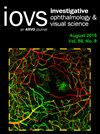Characterizing Presumed Displaced Retinal Ganglion Cells in the Living Human Retina of Healthy and Glaucomatous Eyes.
IF 5
2区 医学
Q1 OPHTHALMOLOGY
引用次数: 0
Abstract
Purpose The purpose of this study was to investigate the large somas presumed to be displaced retinal ganglion cells (dRGCs) located in the inner nuclear layer (INL) of the living human retina. Whereas dRGCs have previously been studied in mammals and human donor tissue, they have never been investigated in the living human retina. Methods Five young, healthy subjects and three subjects with varying types of glaucoma were imaged at multiple locations in the macula using adaptive optics optical coherence tomography. In the acquired volumes, bright large somas at the INL border with the inner plexiform layer were identified, and the morphometric biomarkers of soma density, en face diameter, and spatial distribution were measured at up to 13 degrees retinal eccentricity. Susceptibility to glaucoma was assessed. Results In the young, healthy individuals, mean density of the bright, large somas was greatest foveally (550 and 543 cells/mm2 at 2 degrees temporal and nasal, respectively) and decreased with increasing retinal eccentricity (38 cells/mm2 at 13 degrees temporal, the farthest we measured). Soma size distribution showed the opposite trend with diameters and size variation increasing with retinal eccentricity, from 12.7 ± 1.8 µm at 2 degrees to 15.7 ± 3.5 µm at 13 degrees temporal, and showed evidence of a bimodal distribution in more peripheral locations. Within and adjacent to the arcuate defects of the subjects with glaucoma, density of the bright large somas was significantly lower than found in the young, healthy individuals. Conclusions Our results suggest that the bright, large somas at the INL border are likely comprised of dRGCs but amacrine cells may contribute too. These somas appear highly susceptible to glaucomatous damage.描述健康眼和青光眼活体视网膜中假定移位的视网膜神经节细胞的特征。
目的本研究的目的是调查位于活体视网膜核内层(INL)的推测为移行视网膜神经节细胞(dRGCs)的大体细胞。方法使用自适应光学相干断层扫描技术对五名年轻的健康受试者和三名患有不同类型青光眼的受试者的黄斑多个位置进行成像。在获取的图像中,确定了 INL 与内丛状层交界处明亮的大体块,并在视网膜偏心 13 度的范围内测量了体块密度、表面直径和空间分布的形态生物标志物。结果 在年轻的健康人中,明亮的大体节的平均密度在眼窝处最大(在颞2度和鼻侧分别为550和543个细胞/平方毫米),并随着视网膜偏心率的增加而降低(在颞13度,即我们测量的最远处,为38个细胞/平方毫米)。体节的大小分布呈现出相反的趋势,直径和大小变化随着视网膜偏心率的增加而增加,从颞侧 2 度的 12.7 ± 1.8 µm 到颞侧 13 度的 15.7 ± 3.5 µm,并且在更周边的位置显示出双峰分布的证据。结论我们的研究结果表明,INL 边界的明亮大体块很可能是由 dRGCs 组成的,但也可能是由 amacrine 细胞组成的。这些体节似乎极易受到青光眼的损害。
本文章由计算机程序翻译,如有差异,请以英文原文为准。
求助全文
约1分钟内获得全文
求助全文
来源期刊
CiteScore
6.90
自引率
4.50%
发文量
339
审稿时长
1 months
期刊介绍:
Investigative Ophthalmology & Visual Science (IOVS), published as ready online, is a peer-reviewed academic journal of the Association for Research in Vision and Ophthalmology (ARVO). IOVS features original research, mostly pertaining to clinical and laboratory ophthalmology and vision research in general.

 求助内容:
求助内容: 应助结果提醒方式:
应助结果提醒方式:


